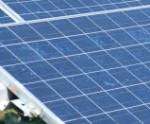According to researchers from North Carolina State University, a new technique for improving the connections between stacked solar cells could lead to next-generation solar energy devices operating at concentrations of up to 70,000 suns.
In work published in Applied Physics Letters, the NC State team demonstrated that by inserting an ultra-thin layer of gallium arsenide (GaAs) into the connecting junction of a stacked solar cell they could eliminate most of the voltage usually lost without affecting solar energy output.
Stacked solar cells are made up of several solar cells stacked together, multiplying the amount of energy produced. They have recorded efficiencies of 45 percent, much higher than standard single-layer cells.
According to Dr. Salah Bedair, lead professor and senior author of the work, these record light-to-power conversion rates make the technology very attractive for use in concentrated solar power technology, where lenses are used to further intensify the sun’s energy at concentrations of up to 5000 suns.
“This should reduce overall costs for the energy industry because, rather than creating large, expensive solar cells, you can use much smaller cells that produce just as much electricity by absorbing intensified solar energy from concentrating lenses. And concentrating lenses are relatively inexpensive,” Bedair said.
But at intensities above 700 suns, the connecting junctions between stacked solar cells begin to break down, and much of the solar energy produced is lost as heat. The more cells are stacked up, the more junctions are created and the more voltage is wasted.
Bedair and fellow researchers found their method made a connecting junction in a stacked solar cell which could withstand the power of 70,000 suns – far more than is ever likely to be needed on Earth. They believe their discovery will lead to cheaper solar power.
“Now we have created a connecting junction that loses almost no voltage, even when the stacked solar cell is exposed to 70,000 suns of solar energy,” Bedair said.
“And that is more than sufficient for practical purposes, since concentrating lenses are unlikely to create more than 4,000 or 5,000 suns worth of energy. This discovery means that solar cell manufacturers can now create stacked cells that can handle these high-intensity solar energies without losing voltage at the connecting junctions, thus potentially improving conversion efficiency.”
Source












































